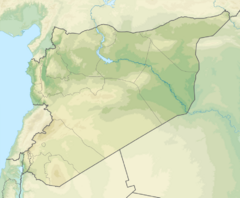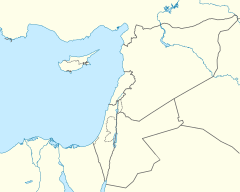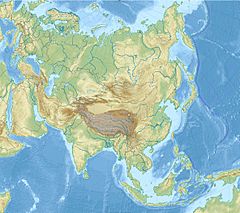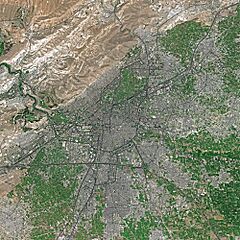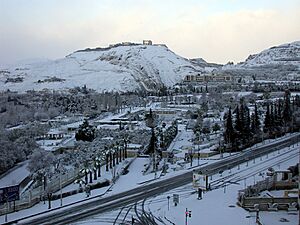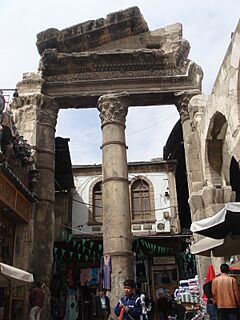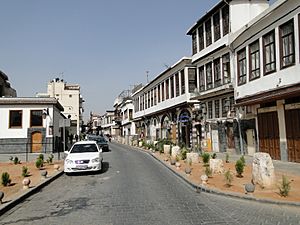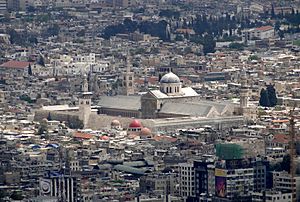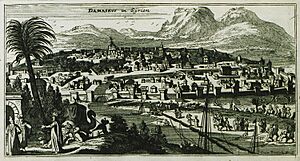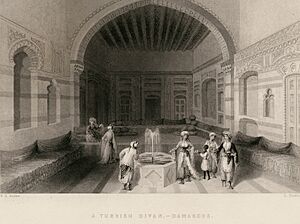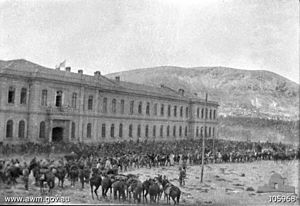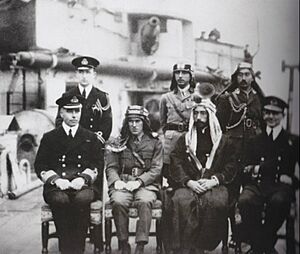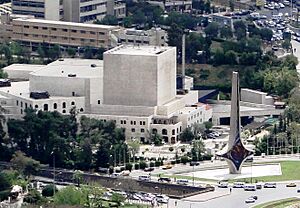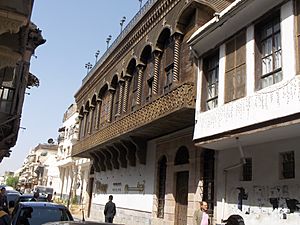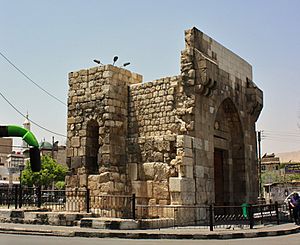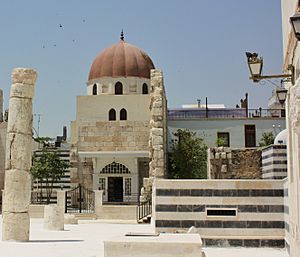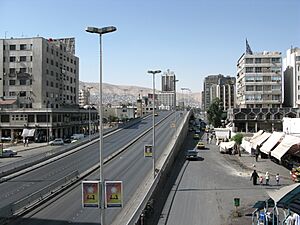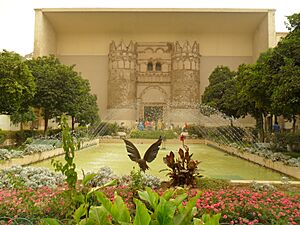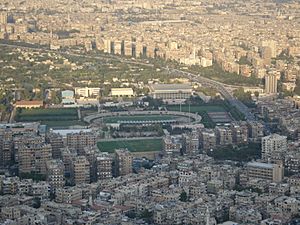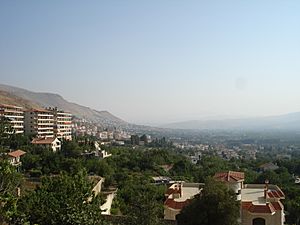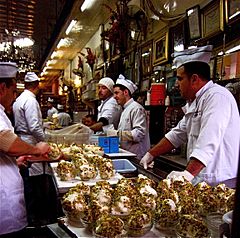Damascus facts for kids
Quick facts for kids
Damascus
دِمَشق
|
|||
|---|---|---|---|
|
Umayyad Mosque
General view of Damascus • Mount Qasioun Maktab Anbar • Azm Palace Sulaymaniyya Takiyya |
|||
|
|||
| Nicknames: | |||
| Country | |||
| Governorate | Damascus Governorate, Capital City | ||
| First settled | c. 10 000 BC | ||
| Municipalities | 16 | ||
| Government | |||
| • Type | Mayor–council government | ||
| Area | |||
| • Metropolis | 105 km2 (41 sq mi) | ||
| • Urban | 77 km2 (29.73 sq mi) | ||
| Elevation | 680 m (2,230 ft) | ||
| Population
(2022 estimate)
|
|||
| • Metropolis | 2,503,000 | ||
| • Rank | 1st in Syria 15th in the Arab World |
||
| • Density | 24,000/km2 (60,000/sq mi) | ||
| • Metro | 2,685,000 | ||
| • Metro density | 7,090/km2 (18,400/sq mi) | ||
| Demonyms | English: Damascene Arabic: دِمَشقِيّ, romanized: Dimašqī |
||
| Time zone | UTC+3 (AST) | ||
| Postal code |
0100
|
||
| Area code(s) | Country code: 963, City code: 11 | ||
| Geocode | C1001 | ||
| ISO 3166 code | SY-DI | ||
| Climate | BWk | ||
| HDI (2021) | 0.612 – medium | ||
| International airport | Damascus International Airport | ||
| Official name: Ancient City of Damascus | |||
| Type: | Cultural | ||
| Criteria: | i, ii, iii, iv, vi | ||
| Designated: | 1979 (3rd session) | ||
| Reference #: | 20 | ||
| Region: | Arab States | ||
Damascus is the capital and largest city of Syria. It is one of the oldest capital cities in the world. Some even say it is the fourth holiest city in Islam. People often call it the "City of Jasmine" because of its beautiful flowers. Damascus is a very important cultural center in the Levant and the Arab world.
The city is in southwestern Syria, surrounded by mountains. It sits about 680 meters (2,230 feet) above sea level. Damascus has a dry climate because the Anti-Lebanon mountains block rain. The Barada River flows through the city, which helped it grow.
Damascus is one of the oldest continuously inhabited cities on Earth. People first settled here around 10,000 BC. It was the capital of the Umayyad Caliphate from 661 to 750 AD. Later, the capital moved to Baghdad. Damascus became important again during the Ayyubid and Mamluk periods. Today, it is where the Syrian government operates.
The city was greatly affected by the Syrian Civil War, which started in 2011. There were many bombings and battles. In 2018, the Syrian government took back control of the entire city. After the war, new building projects began to rebuild Damascus. The Old City of Damascus is famous for its historic places. These include the Umayyad Mosque, Mausoleum of Saladin, and the Jewish Quarter.
Contents
- What is the meaning of the name Damascus?
- Where is Damascus located?
- What is the history of Damascus?
- What is the economy of Damascus like?
- Who lives in Damascus?
- What are the historical sites in Damascus?
- Education in Damascus
- How to get around Damascus?
- What is the culture of Damascus like?
- Twin Towns and Sister Cities
- Notable People from Damascus
- Images for kids
- See also
What is the meaning of the name Damascus?
The name Damascus first appeared in ancient Egyptian records around 1500 BC. Its exact meaning is not fully known. In ancient Aramaic, the name might have meant "a well-watered land." This makes sense because the city has a river and was known for its green areas.
In Arabic, the city is called Dimashq. People in Syria and nearby Arab countries also call it ash-Sham. This name refers to the wider Levant region, which is also called Bilad ash-Sham, meaning "land of the Levant."
Where is Damascus located?
Damascus is in a great location. It is on a plateau about 680 meters (2,230 feet) above sea level. It is about 80 kilometers (50 miles) inland from the Mediterranean Sea. The Anti-Lebanon Mountains protect it. The Barada River provides water. This location made it a key spot for trade routes. These routes connected Egypt with Asia Minor and Lebanon with the Euphrates river.
The Anti-Lebanon Mountains form the border between Syria and Lebanon. These tall mountains, some over 3,000 meters (10,000 feet) high, block rain from the Mediterranean. This is why Damascus has a dry climate. However, the Barada River, fed by melting snow, helped the city thrive in ancient times.
Today, the city covers about 105 square kilometers (41 square miles). The Jabal Qasioun mountain takes up some of this area.
The old city of Damascus is on the south bank of the Barada River. Many neighborhoods grew around it over time. In the 19th century, new areas developed on the slopes of Jabal Qasioun. These were settled by people from different parts of the Ottoman Empire.
Later, a modern center grew west of the old city, near the Barada River. This area, called al-Marjeh, became the main square. New suburbs also grew north and south of the river.
Damascus used to be surrounded by a green oasis called the Ghouta region. The Barada River watered this area. However, as the city grew, the river's flow decreased.
What is the climate like in Damascus?
Damascus has a dry climate. Summers are long, dry, and hot. Winters are cool and a bit rainy. Snowfall is rare. Most rain falls from October to May. The city gets about 130 millimeters (5 inches) of rain each year.
| Climate data for Damascus (Damascus International Airport) 1991–2020 | |||||||||||||
|---|---|---|---|---|---|---|---|---|---|---|---|---|---|
| Month | Jan | Feb | Mar | Apr | May | Jun | Jul | Aug | Sep | Oct | Nov | Dec | Year |
| Record high °C (°F) | 23.2 (73.8) |
28.0 (82.4) |
34.4 (93.9) |
37.6 (99.7) |
41.4 (106.5) |
45.0 (113.0) |
45.8 (114.4) |
44.8 (112.6) |
44.6 (112.3) |
38.0 (100.4) |
31.0 (87.8) |
25.1 (77.2) |
45.8 (114.4) |
| Mean daily maximum °C (°F) | 13.1 (55.6) |
15.3 (59.5) |
20.0 (68.0) |
25.3 (77.5) |
30.9 (87.6) |
35.3 (95.5) |
37.8 (100.0) |
37.6 (99.7) |
34.6 (94.3) |
29.0 (84.2) |
20.6 (69.1) |
14.8 (58.6) |
26.2 (79.1) |
| Mean daily minimum °C (°F) | 0.8 (33.4) |
2.0 (35.6) |
4.8 (40.6) |
8.0 (46.4) |
12.1 (53.8) |
15.9 (60.6) |
18.6 (65.5) |
18.6 (65.5) |
15.3 (59.5) |
11.0 (51.8) |
5.2 (41.4) |
1.9 (35.4) |
9.5 (49.1) |
| Record low °C (°F) | −10.8 (12.6) |
−12 (10) |
−6 (21) |
−7.5 (18.5) |
1.4 (34.5) |
6.2 (43.2) |
10.5 (50.9) |
9.5 (49.1) |
3.5 (38.3) |
−1.0 (30.2) |
−8.6 (16.5) |
−8.8 (16.2) |
−12.0 (10.4) |
| Average precipitation mm (inches) | 26.0 (1.02) |
22.4 (0.88) |
13.9 (0.55) |
5.6 (0.22) |
4.8 (0.19) |
0.3 (0.01) |
0 (0) |
0 (0) |
0.3 (0.01) |
6.3 (0.25) |
21.4 (0.84) |
23.6 (0.93) |
124.7 (4.91) |
| Average precipitation days (≥ 1 mm) | 4.8 | 4.4 | 2.6 | 1.3 | 1.0 | 0.1 | 0.0 | 0.0 | 0.1 | 1.2 | 3.3 | 4.2 | 23.0 |
| Average snowy days | 1 | 1 | 0.1 | 0 | 0 | 0 | 0 | 0 | 0 | 0 | 0 | 0.2 | 2.3 |
| Average relative humidity (%) | 76 | 69 | 59 | 50 | 43 | 41 | 44 | 48 | 47 | 52 | 63 | 75 | 56 |
| Mean monthly sunshine hours | 164.3 | 182.0 | 226.3 | 249.0 | 322.4 | 357.0 | 365.8 | 353.4 | 306.0 | 266.6 | 207.0 | 164.3 | 3,164.1 |
| Mean daily sunshine hours | 5.3 | 6.5 | 7.3 | 8.3 | 10.4 | 11.9 | 11.8 | 11.4 | 10.2 | 8.6 | 6.9 | 5.3 | 8.5 |
| Source: NOAA (humidity, sun 1970–1990) | |||||||||||||
What is the history of Damascus?
Early Settlements and Ancient Times
Evidence shows people lived near Damascus as early as 9000 BC. The city itself was settled around 6300 BC. It became an important city around the 11th century BC when the Aramaeans arrived. They built canals to use the Barada River's water for farming. This system is still partly used today.
Damascus was part of different empires. It was fought over by the Hittites and Egyptians. Later, it became the capital of the Aram-Damascus kingdom. This kingdom often clashed with the Kingdom of Israel. In 853 BC, Damascus led an army that stopped the powerful Neo-Assyrian Empire for a while. But eventually, the Assyrians took control. Then, the Neo-Babylonians conquered Syria, including Damascus.
Greek and Roman Periods
Alexander the Great conquered Damascus. After his death, two empires, the Seleucids and Ptolemies, fought over the city. The Romans took control in 64 BC. They made Damascus part of a group of ten cities called the Decapolis.
The Romans redesigned the city. The old city still has the rectangular shape from Roman times. Its main street, the Damascus Straight Street (also known as Via Recta), was built then. The Romans also built a large gate, Bab Sharqi, which still stands today. Damascus became a very important city for trade during the Roman period. It was a meeting point for trade routes from Arabia, Palmyra, and the Silk Road from China.
Islamic Rule: Umayyad and Abbasid Eras
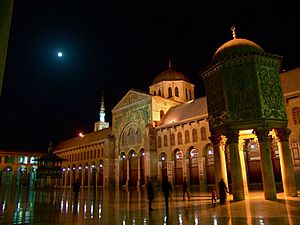
In 634 AD, the Arab Muslim general Khalid ibn al-Walid conquered Damascus. The city became the capital of Islamic Syria. In 661, Mu'awiya I became the caliph (leader) of the Islamic empire. He made Damascus the capital of the entire Caliphate. This was a huge empire stretching from Spain to India.
During this time, the Grand Mosque of Damascus (now the Umayyad Mosque) was built. It was finished in 715 AD. This mosque was built on the site of a Christian church.
However, in 750 AD, the Abbasids took over. They moved the capital to Baghdad. Damascus lost its importance and became a smaller provincial town. Its walls were even torn down. For a long time, Damascus was not as famous.
Seljuq, Ayyubid, and Mamluk Periods
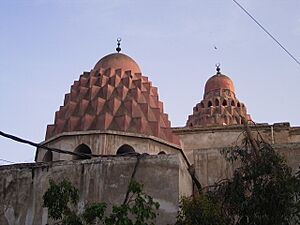
When the Seljuq Turks arrived in the late 11th century, Damascus became a capital again. It grew as a center for Islamic learning. The Crusades began in 1097. Damascus faced attacks from Crusader armies. In 1148, a large Crusader army tried to capture Damascus but failed.
By 1154, Nur ad-Din, a Muslim ruler, controlled Damascus. After his death, Saladin took control in 1174. Saladin was a famous Muslim leader who fought against the Crusaders. He recaptured Jerusalem in 1187. After Saladin's death in 1193, different Ayyubid rulers controlled Damascus and Cairo.
In 1260, the Mongols captured Damascus. But soon after, the Mamluks from Egypt defeated the Mongols and took control. Damascus became a Mamluk provincial capital. In 1400, the conqueror Timur attacked Damascus. He sacked the city and took many artisans to his capital, Samarkand.
Ottoman Rule
In 1516, the Ottoman Empire conquered Damascus. They ruled for the next 400 years. Damascus was important to the Ottomans because it was a starting point for the Hajj (pilgrimage) caravans to Mecca.
During this time, Christians and Jews in Damascus were allowed to practice their religions. However, there were some difficult times. In 1860, fighting between different groups led to a massacre of Christians in the city. Many were saved by the Algerian leader Abd al-Qadir.
Modern History
In the early 20th century, people in Damascus wanted more independence from Ottoman rule. During World War I, in 1918, Prince Faisal and the forces of the Arab Revolt entered Damascus. Faisal was proclaimed king of Syria.
However, after the war, France was given control over Syria by the League of Nations. In 1920, a French army entered Damascus. The French made Damascus the capital of their Mandate for Syria. In 1925, a major revolt spread to Damascus. The French used heavy weapons to stop it, bombing parts of the city.
In 1941, during World War II, British and Free French forces captured Damascus from the French. Syria gained full independence in 1946, and Damascus remained its capital. In 1979, the Old City of Damascus became a World Heritage Site by UNESCO.
Syrian Civil War Impact
Starting in 2012, the Syrian civil war reached Damascus. There were many clashes and bombings. In 2018, the Syrian government took full control of the city.
Because of the war, Damascus has been ranked as one of the least livable cities in the world since 2017. However, new projects have started to rebuild the city.
What is the economy of Damascus like?
Damascus has always been an important trade center. Today, many goods made in Damascus and Syria are sent to countries in the Arabian Peninsula. The city also hosts an annual international trade fair.
Tourism in Damascus has a lot of potential because of its rich history. However, the civil war has made it difficult for tourism to grow. Before the war, many small hotels and cafes opened in the old city, attracting visitors.
New development projects, like Marota City and Basilia City, are being built. These aim to help rebuild the city after the war. Damascus also has a stock exchange, which opened in 2009.
The city has many factories that produce textiles, food, cement, and chemicals. Most of these factories are run by the government.
Who lives in Damascus?

In 2022, Damascus had an estimated population of about 2.5 million people. The larger metropolitan area has about 5 million people. The city's population has grown due to people moving from rural areas for jobs and education.
Ethnic Groups in Damascus
Most people in Damascus are Syrian Arabs. The Kurds are the second largest group, with about 300,000 people. They mainly live in the Wadi al-Mashari and Rukn al-Din neighborhoods. Other smaller groups include Palestinians, Assyrians, Syrian Turkmen, Armenians, and Circassians. There used to be a significant Jewish community, but as of 2023, there are no Jews left.
Religions in Damascus
Religion in Damascus (2024) Sunni Islam (74%) Other Muslim groups (Alawite, Ismailis and Shia) (16%) Christianity (10%)
Islam is the largest religion in Damascus. Most Muslims are Sunni. There are also smaller groups of Alawites and Twelver Shi'a. Alawites mainly live in the Mezzeh districts. Twelvers live near important Shia holy sites like the Sayyidah Ruqayya and Sayyidah Zaynab mosques. Damascus has over 200 mosques, with the Umayyad Mosque being the most famous.
Christians make up about 10%–15% of the population. Several Christian churches have their main offices in Damascus. Christian areas in the city include Bab Tuma, Qassaa, and Ghassani. These areas have many churches, such as the ancient Chapel of Saint Paul.
A small group of Druze also live in the city, especially in mixed neighborhoods like Tadamon and Jaramana.
What are the historical sites in Damascus?
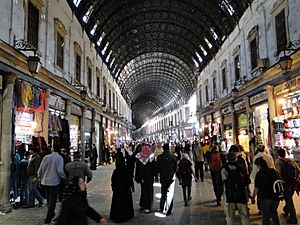
Damascus has many historical sites from different periods. Because the city has been built on top of older layers, many ancient ruins are buried deep below the modern streets.
The Citadel of Damascus is in the northwest part of the Old City. The Damascus Straight Street, also called the Via Recta, was the main Roman street. Today, it is a street with small shops and a covered market called the Souk Medhat Pasha. At the end of this street is the House of Ananias, an underground chapel.
The Umayyad Mosque is one of the largest mosques in the world. It has been a place of worship for a very long time. A shrine inside the mosque is said to hold the body of St. John the Baptist. The tomb of Saladin is just outside the mosque. The Sayyidah Ruqayya Mosque, which holds the tomb of a daughter of Husayn ibn Ali, is also nearby.
The Harat Al Yehud (Jewish Quarter) is a historic area that was popular with tourists before the civil war.
Walls and Gates of Damascus
The Old City of Damascus is surrounded by walls. It has seven gates, some of which are very old. These gates include:
- Bab al-Faradis ("the gate of the orchards")
- Bab al-Salam ("the gate of peace")
- Bab Tuma ("Thomas's Gate"), leading to the Christian quarter
- Bab Sharqi ("eastern gate"), which still has its Roman design
- Bab Kisan, where it is said Saint Paul escaped from Damascus in a basket. This gate is now a chapel.
- Bab al-Saghir (The Small Gate)
- Bab al-Jabiya
Churches in the Old City
- Chapel of Saint Paul
- House of Saint Ananias
- Mariamite Cathedral of Damascus
- Cathedral of the Dormition of Our Lady
- Saint John the Damascene Church
- Saint Paul's Laura
- Saint George's Syriac Orthodox Cathedral
Islamic Sites in the Old City
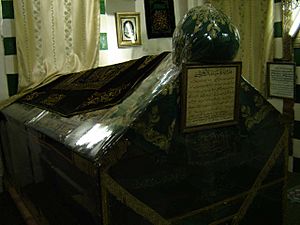
- Umayyad Mosque
- Sayyidah Ruqayya Mosque
- Bab Saghir Cemetery
- Mausoleum of Saladin
- Nabi Habeel Mosque
Old Damascene Houses
- Azm Palace: Built in 1750 for an Ottoman governor, it is now a museum.
- Maktab Anbar: A 19th-century Jewish mansion, now a cultural center.
- Beit al-Mamlouka: A 17th-century house now a luxury hotel.
Threats to the Old City
The Old City of Damascus is facing challenges. Many people have moved out, leaving buildings empty or in disrepair. Some historic areas are threatened by new development plans. Because of these threats, the Old City was placed on the 2008 Watch List of the 100 Most Endangered Sites in the world.
Education in Damascus
Damascus is a major center for education in Syria. It is home to Damascus University, the oldest and largest university in the country. Many new private universities have also opened in and around the city, such as:
- Syrian Virtual University
- International University for Science and Technology
- Syrian Private University
- Arab International University
How to get around Damascus?
Damascus is connected to other major Syrian cities by highways. The M5 goes north to Homs, Hama, Aleppo, and Turkey, and south to Jordan.
The main airport is Damascus International Airport, about 20 kilometers (12 miles) from the city. Before the civil war, it had flights to many countries.
Streets in Damascus can be narrow, especially in the old parts. [[King Long KLQ 6118GQ bus in Damascus.JPG|King Long KLQ 6118GQ bus used for public transport in Damascus|thumb]] Public transport mainly uses buses and minibuses. There are many lines that run through the city and to nearby suburbs. Buses usually stop wherever passengers need to get on or off. More modern buses have been added recently to improve public transport.
The main railway station is now Qadam station in the south of the city. There are plans to build a Damascus Metro system in the future.
What is the culture of Damascus like?
Damascus was chosen as the 2008 Arab Capital of Culture. The city has many museums, including the National Museum of Damascus, Azem Palace, and the Military Museum.
Sports and Fun in Damascus
Popular sports in Damascus include football, basketball, swimming, and tennis. Damascus is home to many football clubs that play in the Syrian Premier League.
The city hosted the Pan Arab Games in 1976 and 1992. The Al-Fayhaa Sports City has a large basketball court and a hall for up to 8,000 people.
Damascus has a lively nightlife. Coffeehouses offer Arabic coffee, tea, and nargileh (water pipes). People often play Card games and backgammon in cafes.
Tishreen Park is one of the largest parks in Damascus. It hosts the annual Damascus Flower Show. The city's famous Ghouta oasis is also a popular place for weekend trips.
Nearby Places to Visit
- Madaya: A small mountain town and holiday resort.
- Bloudan: A town northwest of Damascus, known for its cool summer weather.
- Zabadani: A city near the Lebanese border, popular for its mild weather and views.
- Maaloula: A town where people still speak Western Neo-Aramaic, an ancient language.
- Saidnaya: A mountain city with historical churches.
Twin Towns and Sister Cities
Notable People from Damascus
Images for kids
See also
 In Spanish: Damasco para niños
In Spanish: Damasco para niños









